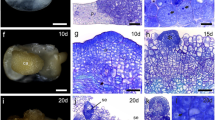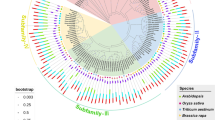Abstract
Arabinogalactan proteins (AGPs) represent a major class of plant hydroxyproline-rich glycoproteins (HRGPs) and are components of cell walls and plasma membranes. AGPs are thought to play roles in cell differentiation, development, and cell-cell interactions. Using a synthetic DNA oligonucleotide based upon an amino acid sequence motif common to AGPs from Lolium, rose, and carrot (i.e., Hyp-Ala-Hyp-Ala-Hyp), we have isolated and sequenced the first AGP gene from a partial Sau3A tomato genomic library packaged in bacteriophage charon 35. The deduced 215 amino acid protein contains 20% Ala, 22% Pro, 10% Gly, and 11% Ser and consists of two Pro-Ala-Pro-Ala-Pro pentapeptide repeats and 16 Ala-Pro dipeptide repeats, consistent with known AGP amino acid compositions and sequences. Comparison of the genomic sequence to a reverse transcribed PCR product and tomato cDNA confirmed the AGP gene is expressed and contains one large intervening sequence. RNA blot hybridization analysis in tomato indicates this AGP gene is strongly expressed in stem and flower, moderately expressed in root and green fruit, and weakly expressed in leaves and red fruit as a 980 nucleotide transcript. Five-day-old seedlings also express this transcript; however, this expression is not regulated by light. More significantly, a gradient of AGP gene expression is observed in tomato stems, ranging from high levels of expression in young internodes to low levels of expression in old internodes. Wounding serves to down-regulate expression in young and old internodes. Heat shock also affects AGP gene expression in stems by transiently down-regulating mRNA levels.
Similar content being viewed by others
References
Anderson SK, Gallinger S, Roder J, Frey J, Young HA, Ortaldo JR: A cyclophilin-related protein involved in the function of natural killer cells. Proc Natl Acad Sci USA 90: 542–546 (1993).
Basile DV, Basile MR: The role and control of the placedependent suppression of cell division in plant morphogenesis and phylogeny. Mem Torrey Bot Club 25: 63–83 (1993).
Bringaud F, Baltz T: Differential regulation of two distinct families of glucose transporter genes in Trypanosoma brucei. Mol Cell Biol 13: 1146–1154 (1993).
Chen C-G, Pu Z-Y, Moritz RL, Simpson RJ, Bacic A, Clarke AE, Mau S-L: Molecular cloning of a gene encoding an arabinogalactan-protein from pear (Pyrus communis) cell suspension culture. Proc Natl Acad Sci USA 91: 10305–10309 (1994).
Cheung AY, Wang H, Wu H-m: A floral transmitting tissuespecific glycoprotein attracts pollen tubes and stimulates their growth. Cell 82: 383–393 (1995).
Du H, Simpson RJ, Moritz RL, Clarke AE, Bacic A: Isolation of protein backbone of an arabinogalactan protein from styles of Nicotiana alata and characterization of a corresponding cDNA. Plant Cell 6: 1643–1653 (1994).
Egertsdotter U, vonArnold S: Importance of arabinogalactan proteins for the development of somatic embryos of Norway spruce (Picea abies). Physiol Plant 93: 334–345 (1995).
Fincher GB, Stone BA, Clarke AE: Arabinogalactan-proteins: structure, biosynthesis, and function. Annu Rev Plant Physiol 34: 47–70 (1983).
Gleeson PA, McNamara M, Wettenhall REH, Stone BA, Fincher GB: Characterization of the hydroxyproline-rich protein core of an arabinogalactan-protein secreted from suspensioncultured Lolium multiflorum (Italian ryegrass) endosperm cells. Biochem J 264: 857–862 (1989).
Green P: Control of mRNA stability in higher plants. Plant Physiol 102: 1065–1070 (1993).
Holland SK, Blake CC: Proteins, exons and molecular evolution. Biosystems 20: 181–206 (1987).
Howarth CJ, Ougham HJ: Gene expression under temperature stress. New Phytol 125: 1–26 (1993).
Jermyn MA, Guthrie R: A final assault on the structure of carrot AGPs. AGP News 5: 4–25 (1985).
Knox JP, Linstead PJ, Peart J, Cooper C, Roberts SK: Developmentally regulated epitopes of cell surface arabinogalactan proteins and their relation to root tissue pattern formation. Plant J 1: 317–326 (1991).
Komalavilas P, Zhu J-K, Nothnagel EA: Arabinogalactanproteins from the suspension culture medium and plasma membrane of rose cells. J Biol Chem 266: 15956–15965 (1991).
Kozak M: The scanning model for translation: an update. J Biol Chem 108: 229–241 (1989).
Kreuger M, vanHolst G-J: Arabinogalactan proteins are essential in somatic embryogenesis of Daucus carota L. Planta 189: 243–248 (1993).
Lawton MA, Lamb CJ: Transcriptional activation of plant defense genes by fungal elicitor, wounding, and infection. Mol Cell Biol 7: 335–341 (1987).
Loopstra CA, Sederoff RR: Xylem-specific gene expression in loblolly pine. Plant Mol Biol 27: 277–291 (1995).
Mau S-L, Chen C-G, Pu Z-Y, Moritz RL, Simpson RJ, Bacic A, Clarke AE: Molecular cloning of cDNAs encoding the protein backbones of arabinogalactan proteins from the filtrate of suspension-cultured cells of Pyrus communis and Nicotiana alata. Plant J 8: 269–281 (1995).
Murray E, Lotzer J, Eberle M: Codon usage in plant genes. Nucl Acids Res 17: 477–498 (1989).
Pennell RI: Cell surface arabinogalactan proteins, arabinogalactans and plant development. In: Callow JA, Green JR (eds) Perspectives in Plant Cell Recognition, pp. 105–121. Cambridge University Press, Cambridge (1992).
Pennell RI, Ianniche L, Kjellbom P, Scofield GN, Peart JM, Roberts K: Developmental regulation of a plasma membrane arabinogalactan protein epitope in oilseed rape flowers. Plant Cell 3: 1317–1326 (1991).
Pennell RI, Roberts K: Sexual development in the pea is presaged by altered expression of arabinogalactan protein. Nature 344: 547–549 (1990).
Pogson B, Davies C: Characterization of a cDNA encoding the protein moiety of a putative arabinogalactan protein from Lycopersicon esculentum. Plant Mol Biol 28: 347–352 (1995).
Promega Corporation: Promega Protocols and Applications Guide. Promega Corporation, Madison, WI (1991).
Sambrook J, Fritsch EF, Maniatis T: Molecular Cloning: A Laboratory Manual. Cold Spring Harbor Laboratory Press, Cold Spring Harbor, NY (1989).
Schindler T, Bergfeld R, Schopfer P: Arabinogalactan proteins in maize coleoptiles: developmental relationship to cell death during xylem differentiation but not to extension growth. Plant J 7: 25–36 (1995).
Serpe MD, Nothnagel EA: Effects of Yariv phenylglycosides on Rosa cell suspensions: evidence for the involvement of arabinogalactan-proteins in cell proliferation. Planta 193: 542–550 (1994).
Showalter AM: Structure and function of plant cell wall proteins. Plant Cell 5: 9–23 (1993).
Showalter AM, Rumeau D: Molecular biology of plant cell wall hydroxyproline-rich proteins. In: Adair WS, Mecham RP (eds) Organization and Assembly of Plant and Animal Extracellular Matrix, pp. 247–281. Academic Press, New York (1990).
Showalter AM, Varner JE: Plant hydroxyproline-rich glycoproteins. In: Marcus A (ed) The Biochemistry of Plants, pp. 485–536. Academic Press, New York (1989).
Showalter AM, Zhou J, Rumeau D, Worst SG, Varner JE: Tomato extensin and extensin-like cDNAs: structure and expression in response to wounding. Plant Mol Biol 16: 547–565 (1991).
Stacey NJ, Roberts K, Knox JP: Patterns of expression of the JIM4 arabinogalactan-protein epitope in cell cultures and during somatic embryogenesis in Daucus carota L. Plant 180: 285–292 (1990).
Zhang S, Mehdy MC: Binding of a 50-kD protein to a U-rich sequence in an mRNA encoding a proline-rich protein that is destabilized by fungal elicitor. Plant Cell 6: 135–145 (1994).
Zhu J-K, Bressan RA, Hasegawa PM: Loss of arabinogalactan-proteins from the plasma membrane of NaCl-adapted tobacco cells. Planta 190: 221–226 (1993).
Author information
Authors and Affiliations
Rights and permissions
About this article
Cite this article
Li, Sx., Showalter, A.M. Cloning and developmental/stress-regulated expression of a gene encoding a tomato arabinogalactan protein. Plant Mol Biol 32, 641–652 (1996). https://doi.org/10.1007/BF00020205
Received:
Accepted:
Issue Date:
DOI: https://doi.org/10.1007/BF00020205




